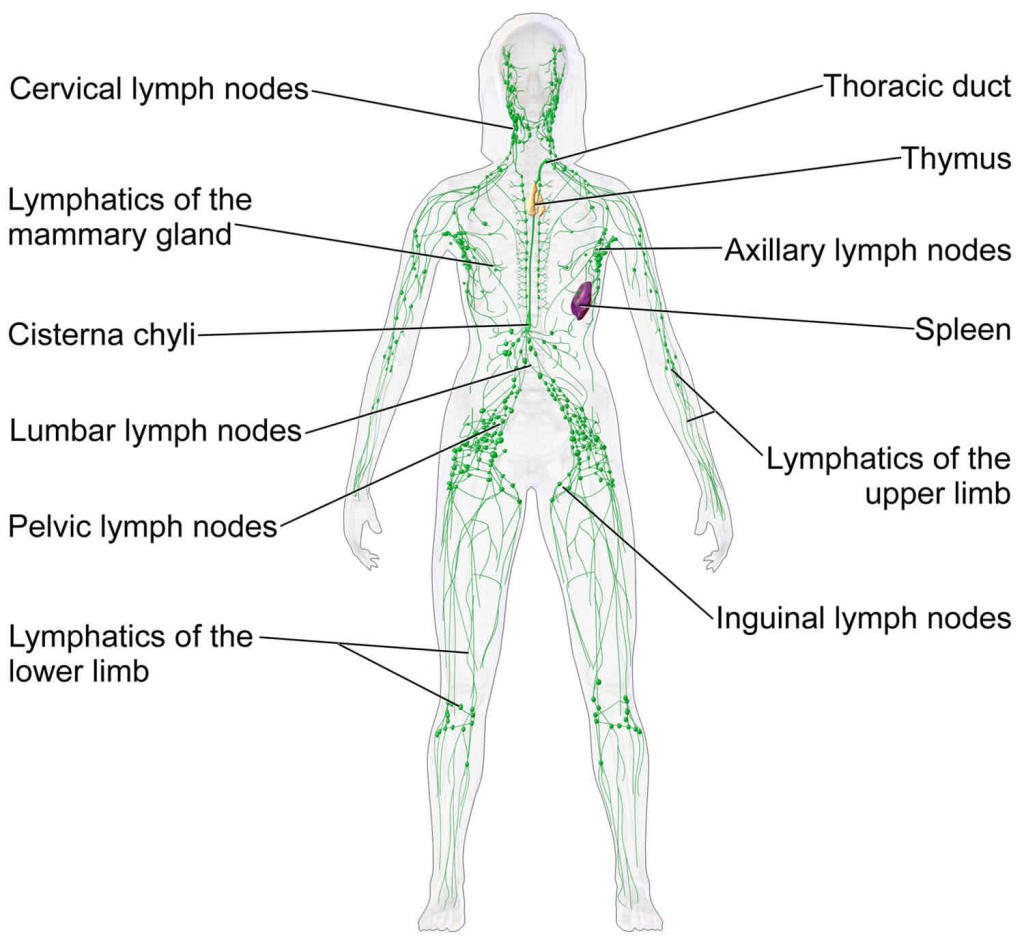Advanced Lymph Node & Glandular Examination (Granthi & Upasneha Pariksha) – Integrating Ayurveda & Modern Medicine
Introduction
Granthi (lymph nodes) and Upasneha (glands) play a crucial role in immune function, detoxification, and hormonal balance. In Ayurveda, abnormalities in lymph nodes and glands indicate Kapha & Pitta imbalances, while in modern medicine, they are associated with infections, malignancies, and endocrine disorders.

This guide provides an advanced, clinically relevant approach to lymph node and gland examination, integrating Ayurvedic principles with modern diagnostic methods, along with tables and practical applications for practitioners.
1. Ayurvedic Concept of Lymph Nodes & Glands
Ayurveda describes lymphatic swellings and glandular disorders under Granthi (localized swellings), Arbuda (tumors), and Upasneha (glandular enlargements). These conditions are linked to dosha imbalances affecting Rakta (blood), Meda (fat), Kapha (lymphatic tissue), and Majja Dhatu (bone marrow & immune function).
Comparison of Ayurvedic & Modern Classification of Lymph Nodes & Glands
| Ayurvedic Term | Dosha Dominance | Modern Equivalent | Clinical Significance |
|---|---|---|---|
| Granthi (Small Nodular Swellings) | Kapha-Vata | Enlarged Lymph Nodes | Lymphadenopathy |
| Arbuda (Tumor-like Growths) | Kapha-Pitta | Benign/Malignant Tumors | Lymphoma, Cancer |
| Shotha (Inflamed Swelling) | Pitta-Rakta | Acute Lymphadenitis | Bacterial/Viral Infection |
| Upasneha (Glandular Swelling) | Kapha-Pitta | Endocrine Disorders | Thyroid, Parotid, Salivary Glands |
🔎 Clinical Application:
- Helps differentiate between benign, inflammatory, and malignant glandular swellings.
- Ayurvedic diagnosis guides detoxification & immune modulation therapies.
2. Lymph Node & Glandular Palpation Techniques
Ayurvedic & Modern Palpation Methods
| Ayurvedic Method | Purpose | Modern Equivalent | Clinical Significance |
|---|---|---|---|
| Mridu Sparshana (Soft Touch) | Identifies Kapha-related swellings | Light palpation | Detects soft, cystic nodes (lipomas, thyroid cysts) |
| Kathina Sparshana (Hardness Check) | Assesses fibrosis & malignancy | Firm palpation | Identifies solid, hard tumors (lymphomas, carcinomas) |
| Ushna Sparshana (Temperature Check) | Detects inflammation | Temperature assessment | Hot, tender nodes indicate infection |
| Gati Pariksha (Mobility Test) | Differentiates benign vs. malignant nodes | Mobility test | Fixed nodes suggest malignancy |
| Pichila Sparshana (Sticky/Adhesive Feel) | Assesses Kapha stagnation | Consistency check | Sticky, matted nodes indicate TB, lymphoma |
🔎 Clinical Application:
- Soft, mobile nodes → benign (reactive lymphadenopathy).
- Hard, fixed nodes → concerning (cancer, chronic infection).
- Warm, tender nodes → acute infection (tonsillitis, TB).
3. Dosha-Based Lymphatic Disorders & Modern Correlation
Ayurvedic & Modern Lymphatic Pathologies
| Lymphatic Condition | Dosha Imbalance | Modern Medical Correlation | Clinical Features |
|---|---|---|---|
| Soft, swollen, non-tender nodes | Kapha | Reactive Lymphadenopathy | Common viral/bacterial response |
| Painful, hot, red swollen nodes | Pitta | Lymphadenitis | Fever, infection (tonsillitis, TB) |
| Hard, fixed, irregular nodes | Kapha-Pitta | Lymphoma, Carcinoma | Chronic, non-tender, firm mass |
| Generalized lymph node enlargement | Kapha-Vata | Hodgkin’s/Non-Hodgkin’s Lymphoma | Weight loss, night sweats |
| Pitting lymphatic edema | Kapha-Meda Dushti | Lymphedema | Swollen limb, post-surgical lymph obstruction |
🔎 Clinical Application:
- Differentiates between acute & chronic lymphadenopathies.
- Helps early detection of malignancies & systemic infections.
4. Glandular Enlargement (Upasneha Vikara) – Ayurvedic & Modern View
Comparison of Glandular Disorders in Ayurveda & Modern Medicine
| Ayurvedic Disorder | Dosha Dominance | Modern Equivalent | Clinical Features |
|---|---|---|---|
| Galaganda (Thyroid Swelling) | Kapha-Pitta | Goiter, Thyroiditis | Neck swelling, metabolic symptoms |
| Mukhapaaka (Salivary Gland Inflammation) | Pitta-Rakta | Parotitis (Mumps) | Swollen parotid glands, fever |
| Medo Granthi (Fatty Glandular Swellings) | Kapha-Meda | Lipomas, Sebaceous Cysts | Soft, mobile, painless lumps |
| Shotha (Inflamed Swelling of Glands) | Pitta-Kapha | Lymphadenitis | Tender, swollen, hot nodes |
🔎 Clinical Application:
- Ayurvedic Kapha-Pitta evaluation aids in thyroid & salivary gland pathology diagnosis.
- Swelling patterns help in early endocrine & inflammatory disorder detection.
5. Malignant & Tubercular Lymph Node Identification
Ayurvedic & Modern Diagnosis of Chronic Lymphatic Disorders
| Finding | Ayurvedic Interpretation | Modern Medical Correlation |
|---|---|---|
| Hard, fixed, irregular nodes | Kapha-Arbuda (Tumor) | Malignant Lymphoma |
| Matted, painless, progressively enlarging nodes | Kapha-Vata Dushti | Tuberculosis Lymphadenitis |
| Soft, painful, rapidly growing nodes | Pitta-Kapha Shotha | Acute Suppurative Lymphadenitis |
🔎 Clinical Application:
- Early differentiation of malignancies from infections.
- Guides immune-strengthening & detoxification therapies.
6. Thyroid & Endocrine Gland Examination (Kapha-Pitta Disorders)
Comparison of Ayurvedic & Modern Thyroid Disorders
| Finding | Ayurvedic Interpretation | Modern Diagnosis |
|---|---|---|
| Large, soft, slow-growing swelling | Kapha Galaganda | Hypothyroidism (Goiter) |
| Warm, tender, fast-growing gland | Pitta Galaganda | Hyperthyroidism (Thyroiditis) |
| Hard, irregular thyroid mass | Arbuda (Malignancy) | Thyroid Cancer |
🔎 Clinical Application:
- Helps early detection of metabolic disorders.
- Integrates Ayurvedic rasayana therapies with modern hormone management.